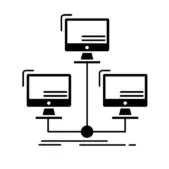The tremendous growth of Internet of Things (IoT) devices in recent years demonstrates clear value and demand for connected technology. In 2023, there were 15.9 billion IoT devices, expected almost to double in less than a decade. By 2030, it is estimated that there will be over 32.1 billion IoT devices globally. With such rapid growth and development, a set of clearly defined best practices for creating superior UX design for IoT-enabled devices has yet to be implemented.
This, however, doesn’t mean there aren’t ways to determine what makes for a great IoT user experience. This article explores four essential principles to consider when developing your organization’s relationship with the Internet of Things. These elements will help you enhance the UX and ensure your IoT devices are intuitive, engaging, and beneficial for customers. By following these guidelines, you can create IoT products that stand out and foster long-term loyalty with your user base.

1. Creating Added Value Through UX Design
The key to creating a great user experience for IoT devices is to focus on how the technology can provide tangible, valuable benefits to the user’s life. Take, for example, a smart refrigerator. Most people get along well enough with their standard refrigerator. So, how can companies justify selling smart refrigerators for thousands of dollars?
The actual added value of a smart refrigerator doesn’t come from flashy features. Instead, it comes from smart sensors and automation that address real user needs. When designing the UX for an IoT product, it’s important to understand the user’s pain points and frustrations deeply. What everyday tasks or challenges can be made easier, more efficient, or even eliminated through connected technology? By identifying these opportunities, you can craft an experience that seamlessly integrates the IoT device into the user’s daily routine to save them time, money, or effort.
The smart refrigerator’s UX is centered around reducing food waste and making grocery shopping more convenient. The cameras and sensors monitor food freshness and stock levels, then proactively notify the user when it’s time to use up certain items or add something to the shopping list. This anticipates the user’s needs before they even realize them, creating a sense of delight and removing tedious chores from their to-do list.
Ultimately, great IoT UX design identifies the user’s core needs and leverages connected technology to deliver a meaningful, beneficial experience. By putting the user first and focusing on tangible value, you can justify the premium price tag of IoT devices and build brand loyalty.

2. Design With New Platforms in Mind
In the early days of the Internet of Things, many IoT devices were extensions of the smartphones and tablets that consumers were already familiar with. The user experience often centered around companion mobile apps that provided control and monitoring capabilities for connected devices.
However, the rapid rise of virtual assistants like Alexa, Siri, and Google Assistant has ushered in a new era of IoT interaction. These voice-controlled platforms have become the primary interface for many smart homes and connected devices.
Designing IoT experiences for virtual assistants requires a fundamentally different approach compared to traditional touchscreen-based interfaces. Instead of relying on visual menus and controls, you need to optimize UX design for natural language processing and audio-based interactions.
This shift demands that your IoT product team leans more heavily on automation and machine learning to power devices. The user experience needs to be seamless and conversational, allowing users to issue voice commands and receive auditory feedback without having to navigate complex hierarchies or control panels.
IoT devices designed for virtual assistants also need to integrate and interoperate with a wide range of connected products and services. The user experience should feel cohesive, even though the underlying technology involves multiple platforms and ecosystems. By keeping these new interaction paradigms in mind, you can ensure your products are compatible, convenient, and functional.

3. Simplicity Is More Important Than Ever
The interconnected world of the Internet of Things offers incredible opportunities to enhance the user experience through new communications capabilities and data-driven features. However, be careful not to overwhelm users with the sheer complexity of this technology.
When designing IoT experiences, resist the urge to cram in every possible feature or function. Users don’t necessarily want to see or understand the intricate web of devices, sensors, and data powering your product. Instead, your UX design should keep the user interface simple and focused on the core value proposition.
That said, simplicity doesn’t have to mean limiting functionality. You can still provide a wide range of capabilities but present them intuitively and easily. Incorporate personalization options that allow users to unlock advanced features or customizations as their comfort and familiarity with the IoT device grows over time.
The key is striking the right balance—delivering a streamlined, approachable experience upfront while enabling users to dive deeper and extract more value from the IoT technology as needed. This will ensure your products don’t get bogged down in complexity but remain engaging, beneficial, and delightful for the user.
4. Plan for the Entire Customer Experience, Not Just the Product
Even the best, most efficient, and functional IoT products, backed by impressive marketing and customer acquisition plans, can fail. The reason is that companies overlook what happens when a customer uses their product for the first time. They forget that customers won’t understand the product as intimately as the engineers who built it. They also forget that most customers rarely read instruction manuals.
To avoid this pitfall, investing in user and product research before launch is critically important. Carefully consider the entire customer journey in your UX design, from the “unboxing” to the initial setup and pairing processes. Ensure these touchpoints are as seamless as possible so new users can quickly realize the value of your IoT device.
By planning for the full customer experience lifecycle, not just the core product functionality, you can maximize the chances of long-term success.
Leveraging UX Design for a Competitive Advantage
The developers, engineers, and business leaders who pay attention to these four UX design elements when creating innovative IoT products will have a distinct competitive advantage in tomorrow’s market. At UpTop, our expert UX designers, strategists, and developers are passionate about creating exceptional digital experiences. From user research to UX strategy, design, and product development, we partner with you to optimize your digital products for long-term user satisfaction and profitability.
Ready to leverage UX for a competitive advantage? Let’s connect.


